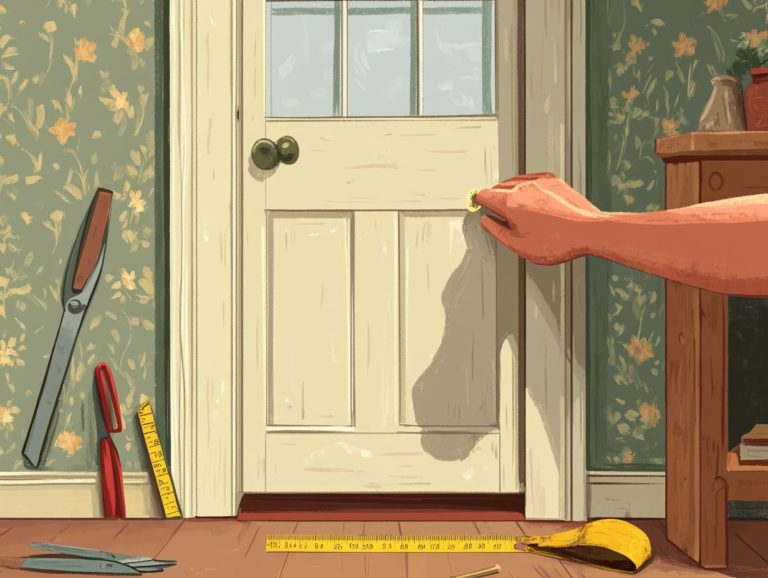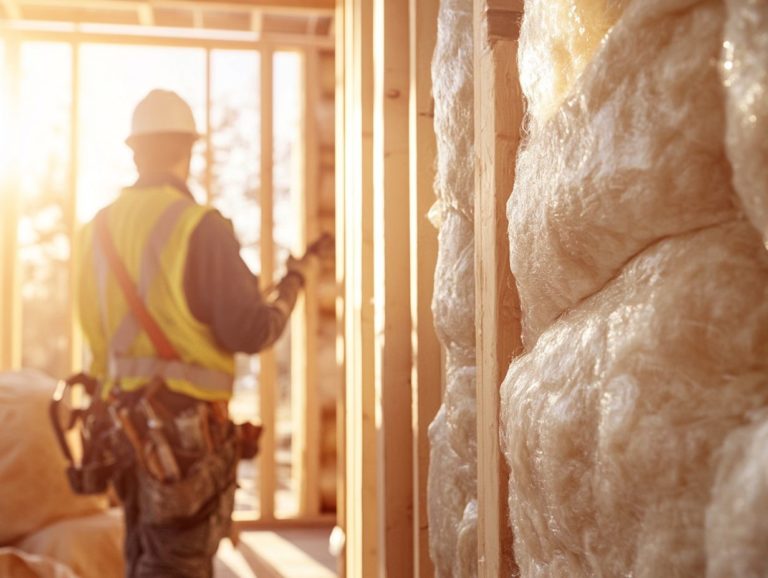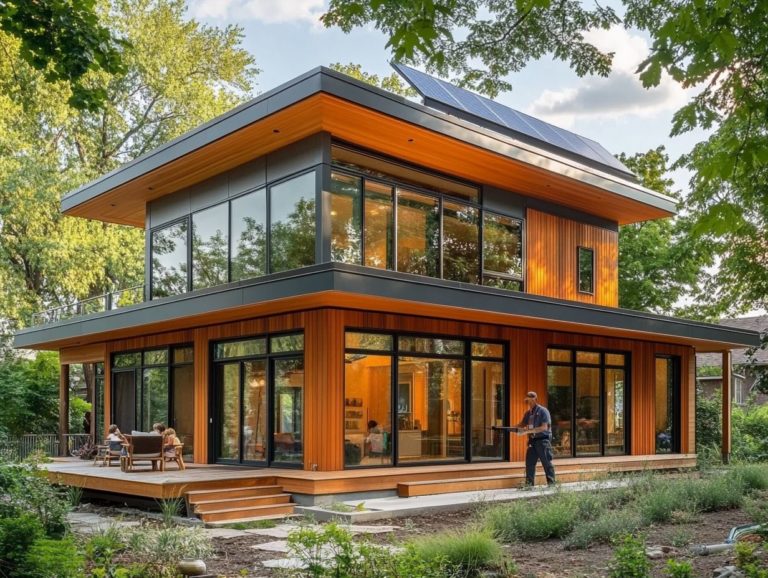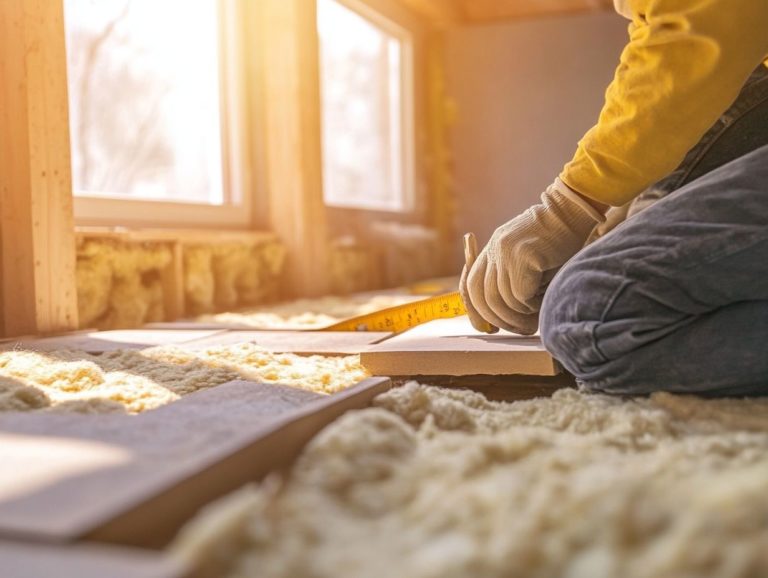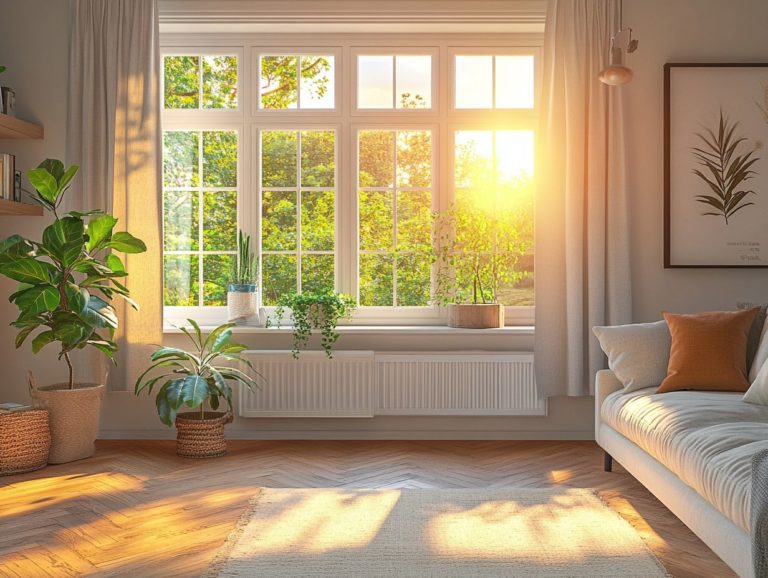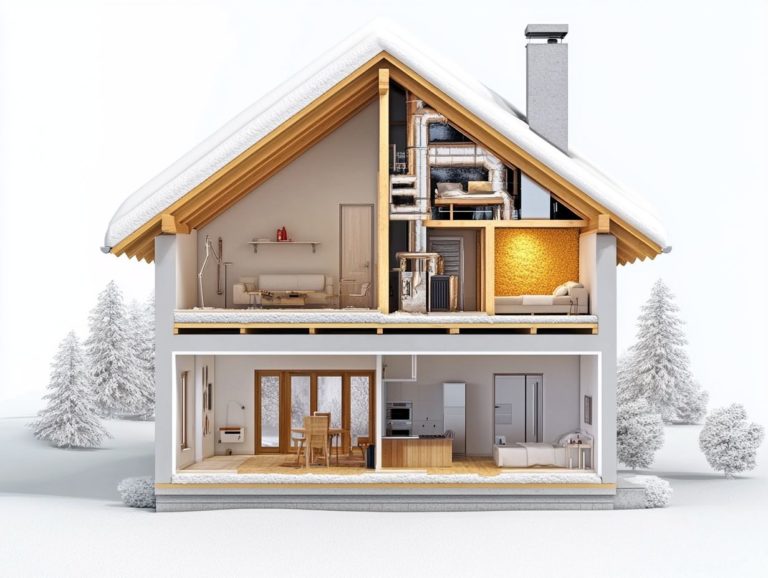DIY Insulation Projects for Homeowners
Insulation is key to achieving a comfortable and energy-efficient home.
Whether your goal is to trim those energy bills, dampen noise, or elevate your overall comfort, gaining a solid understanding of insulation is vital. This article delves into the significance of insulation, the diverse materials at your disposal, and practical tips for DIY projects tailored to various areas of your home.
You ll uncover how to identify the right insulation for your specific needs, the essential tools you ll require, and the common pitfalls to steer clear of. Dive into this guide and discover how proper insulation can truly transform your living space!
Contents
- Key Takeaways:
- 1. Why Insulation Is Important for Your Home
- 2. Types of Insulation Materials
- 3. How to Determine the Right Type of Insulation for Your Home
- 4. Tools and Materials Needed for DIY Insulation Projects
- 5. Attic Insulation
- 6. Wall Insulation
- 7. Basement Insulation
- 8. Crawlspace Insulation
- 9. Garage Insulation
- 10. Insulating Windows and Doors
- 11. Insulating Pipes and Ductwork
- 12. Safety Measures to Take When Insulating Your Home
- 13. Common Mistakes to Avoid When Insulating Your Home
- 14. How to Tell If Your Home Needs More Insulation
- 15. Hiring a Professional vs. DIY Insulation Projects
- Frequently Asked Questions
- What are some benefits of DIY insulation projects for homeowners?
- What are some common types of insulation used in DIY projects?
- How do I determine what type of insulation to use for my DIY project?
- What tools and materials will I need for a DIY insulation project?
- Are there any safety precautions I should take when completing a DIY insulation project?
- Do I need any special skills or knowledge to complete a DIY insulation project?
Key Takeaways:
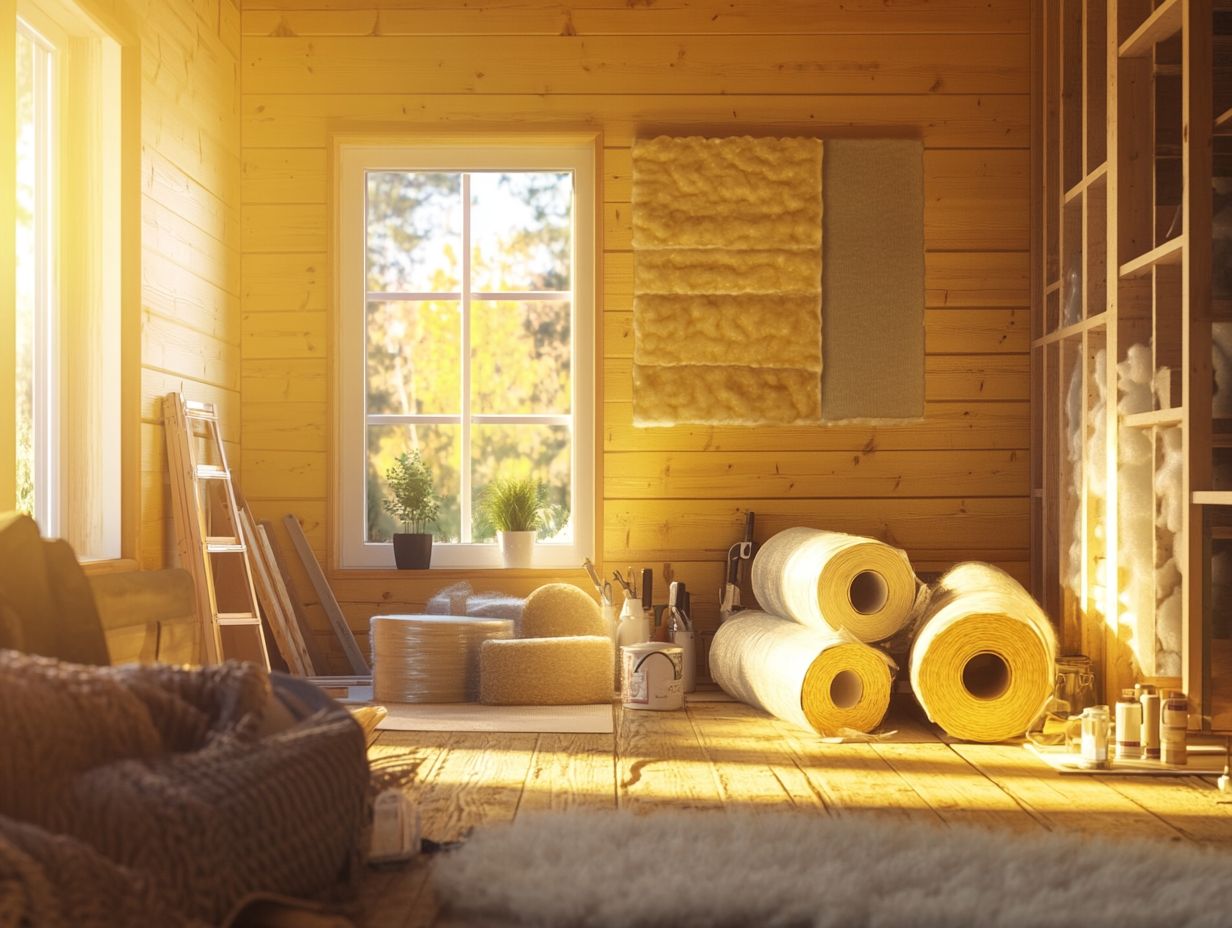
Insulation is crucial for energy efficiency and comfort in your home.
Understanding the different types of insulation materials can help you choose the right one for your home.
DIY insulation projects require proper tools, materials, and safety precautions for successful results. Additionally, following insulation maintenance tips for homeowners can ensure your efforts yield long-lasting benefits.
1. Why Insulation Is Important for Your Home
Insulation is essential for creating a comfortable living environment. It also significantly impacts your energy savings and reduces your home’s carbon footprint.
By effectively insulating your home, you can enhance both heating and cooling efficiency. This translates to lower energy bills and improved overall comfort.
This isn t just a win for your wallet; it also helps the environment. For homeowners like you seeking expert guidance, professionals such as Reuben Saltzman and firms like Structure Tech in Minnesota are invaluable resources.
Understanding the significance of insulation is crucial for getting these benefits, especially when following advice from reputable sources like the Environmental Protection Agency and Energy.gov.
Proper insulation helps maintain a stable indoor temperature and minimizes the need for excessive heating or cooling. The U.S. Department of Energy notes that up to 30% of energy loss in homes can be attributed to inadequate insulation.
This inefficiency can lead to higher energy bills and increased greenhouse gas emissions. Studies suggest that improving your home’s insulation can reduce energy consumption by 20-50%, significantly lowering utility costs and promoting environmental responsibility.
By choosing eco-friendly insulation materials, you can further minimize your ecological impact. Insulation is not just a financial decision; it’s also a step toward a greener planet.
2. Types of Insulation Materials
Understanding the various types of insulation materials available is crucial for making informed decisions. Each material boasts distinct characteristics designed to meet diverse needs.
Take fiberglass insulation, for example. It’s celebrated for its exceptional thermal performance and moisture resistance, making it a go-to choice for attics and walls.
If you’re leaning towards sustainability, cellulose is an excellent option crafted from recycled paper, it perfectly aligns with eco-friendly living.
Then there’s rigid foam insulation, which delivers impressive insulating values in a slimmer profile, making it ideal for basements and crawlspaces.
Don’t overlook polyurethane spray foam; its remarkable air-sealing capabilities can significantly cut your energy bills.
By exploring these options, you can discover the perfect insulation solution tailored to your specific circumstances.
3. How to Determine the Right Type of Insulation for Your Home
Choosing the right type of insulation for your home requires a thorough assessment of your specific needs and existing issues. This assessment is often made clearer with the guidance of an expert.
Home design significantly influences insulation requirements. For example, a sprawling ranch house will typically have different needs than a multi-story Victorian.
If your home is older, it may lack modern building materials, making it more prone to air leaks. In contrast, newer constructions might already boast adequate insulation.
Begin by pinpointing problem areas, like drafty windows or chilly rooms. Consider insulation options such as fiberglass for walls or foam boards for basements to effectively address those specific concerns.
If you’re a DIY enthusiast, keep in mind factors like R-value and ease of installation when selecting ideal materials. R-value measures insulation’s resistance to heat flow. The higher the R-value, the better the insulation.
This will help you create a more energy-efficient and comfortable living environment.
4. Tools and Materials Needed for DIY Insulation Projects
Embarking on a DIY insulation project requires the right materials and essential tools. To achieve this effectively, check out how to retrofit insulation in existing homes. This ensures a successful installation that boosts your home’s energy efficiency.
Before you dive in, gather the following:
- A utility knife for precise cuts.
- A measuring tape for accuracy.
- Safety gear like gloves and masks to protect against irritants.
Popular insulating materials, such as fiberglass batts or foam board, work wonders. Adhesives and sealants help create airtight barriers that prevent energy loss.
As you tackle these projects, remember to follow safety protocols. Ensure good ventilation and handle materials carefully. Measure twice and cut once; precision maximizes insulation effectiveness.
5. Attic Insulation
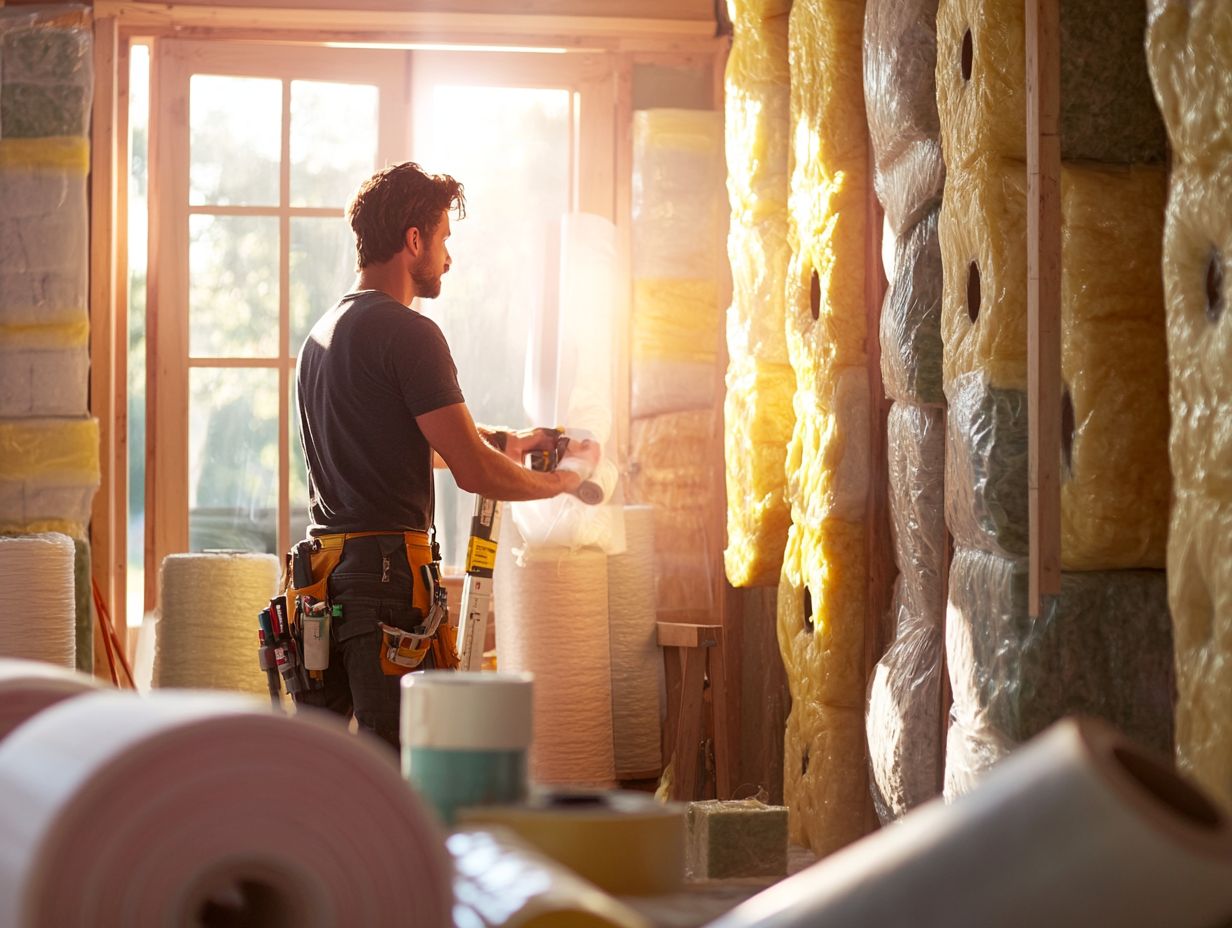
Attic insulation is important for maintaining your home’s temperature and energy efficiency. It addresses air leaks that can inflate your heating and cooling bills.
By insulating your attic effectively, you can significantly lower energy costs. This creates a comfortable living space throughout the year.
There are various insulation options, such as fiberglass batts, spray foam, and blown-in cellulose. Each option offers unique advantages suited to different attic configurations and climates.
First, pinpoint air leaks, often found around ductwork, vents, and electrical penetrations. Sealing these leaks with caulk or weatherstripping before adding insulation greatly improves efficiency.
6. Wall Insulation
Wall insulation enhances your home’s comfort and energy efficiency. It prevents heat loss and reduces the need for excessive heating and cooling.
You have several wall insulation options, including fiberglass batts, foam board, and spray foam. Each offers distinct advantages and different installation techniques.
- Fiberglass batts fit between wall studs and are user-friendly for DIY enthusiasts.
- Foam board provides a rigid solution that attaches directly to exterior walls, improving thermal resistance.
- Spray foam fills gaps and creates an airtight seal, boosting energy efficiency.
Choosing the right insulation optimizes temperature control and reduces utility bills. This leads to a more sustainable living environment.
7. Basement Insulation
Insulating your basement helps regulate temperature and address moisture issues. This is crucial for both comfort and your home’s structural integrity.
Effective insulation strategies create a dry and energy-efficient environment. Choose moisture barriers that resist water and ensure they are properly integrated during installation.
Using closed-cell spray foam or rigid foam boards provides a strong defense against dampness while enhancing thermal performance.
Quality insulation cuts heating and cooling costs while fostering a healthier space by preventing mold growth. Investing in proper basement insulation is essential for protecting your home and its inhabitants.
8. Crawlspace Insulation
Crawlspace insulation is crucial for maintaining energy efficiency and addressing moisture issues. This impacts your home s overall health.
To maximize insulation benefits in these overlooked spaces, incorporate moisture barriers to prevent dampness and mold growth. Proper installation techniques, like ensuring a snug fit and using non-permeable materials, enhance effectiveness.
Consider adding vapor retarders on the ground and sealing cracks or gaps in the foundation walls. This creates a consistent environment.
By prioritizing these strategies, you can reduce energy costs and preserve the structural integrity and comfort of your indoor space.
9. Garage Insulation
Garage insulation plays a vital role in enhancing energy savings and comfort. It creates a controlled environment that positively impacts the nearby living spaces.
By effectively insulating your garage, you can significantly reduce heat loss during colder months while keeping unwanted heat at bay in summer. This leads to a more stable temperature in the rooms connected to the garage.
You have various materials at your disposal, such as fiberglass batts, spray foam, and rigid foam boards. Each offers unique benefits tailored to your budget and specific needs.
Proper insulation also minimizes noise transfer between the garage and your living areas, creating a quieter space.
As a result, not only will your temperatures be more manageable, but your overall utility costs will also decrease. Investing in garage insulation is a decision you won t regret.
10. Insulating Windows and Doors
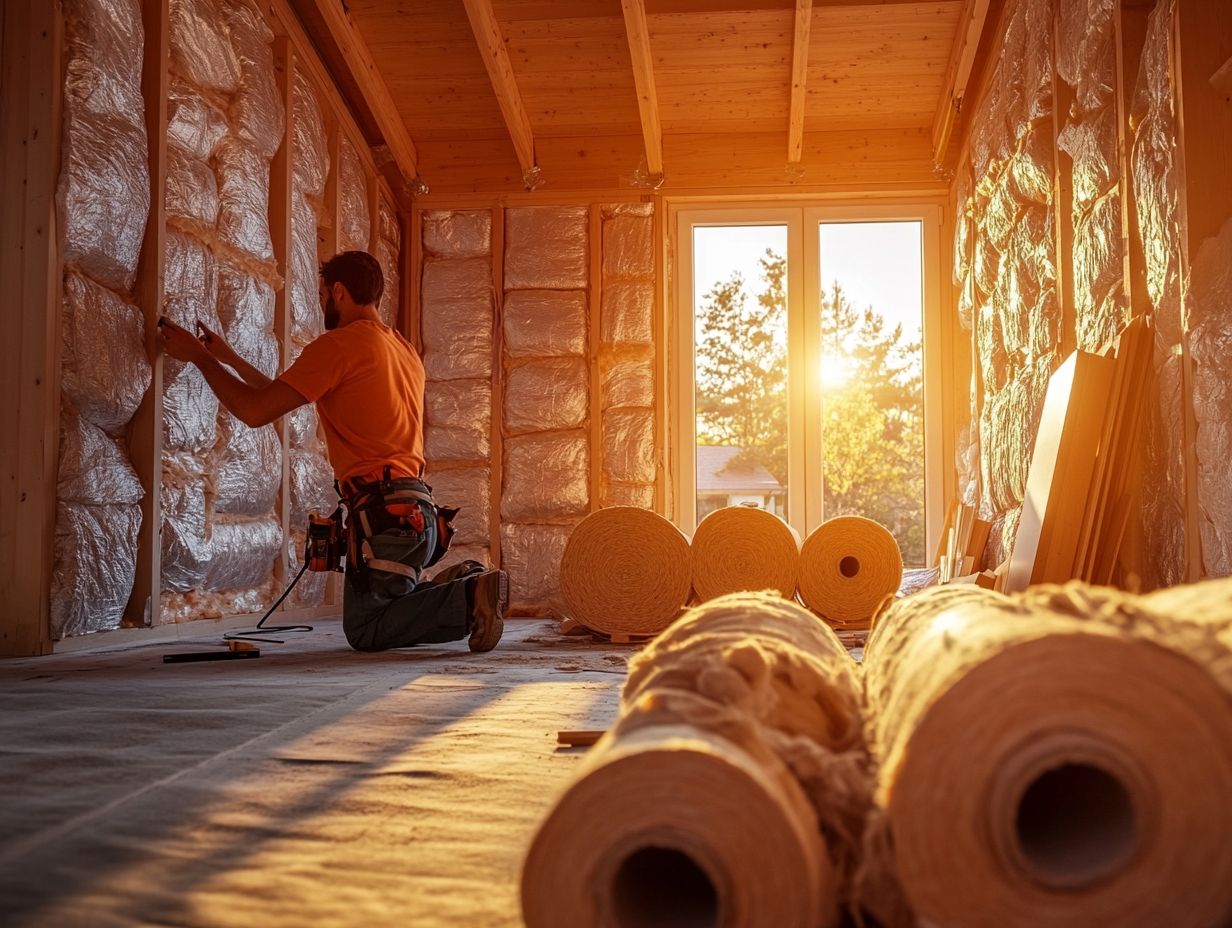
Properly insulating your windows and doors is crucial for enhancing your home’s overall comfort and achieving significant energy savings. By employing various insulation methods, you can create a more energy-efficient living space.
Weather stripping is one effective technique; it forms a barrier that blocks out cold drafts in winter and keeps cool air indoors during summer. Thermal window blinds are another excellent option when closed, they repel heat and bring aesthetic appeal to any room.
Using draft excluders near exterior doors can significantly reduce air exchange, conserving energy and lowering your heating or cooling costs. Together, these strategies create a comprehensive approach to energy conservation that benefits both your wallet and your comfort.
11. Insulating Pipes and Ductwork
Insulating your pipes and ductwork is essential for elevating energy efficiency and ensuring consistent comfort levels throughout your home. By choosing high-quality insulation materials like fiberglass, foam, or rubber, you can significantly cut down on energy consumption and prevent costly heat loss during colder months.
Techniques such as blanket wrapping for pipes or specialized duct insulation help maintain the desired temperatures within your system, enhancing HVAC (Heating, Ventilation, and Air Conditioning) performance. These proactive measures lead to lower energy bills and foster a more environmentally friendly living space.
When installed correctly, insulation acts as a protective barrier, reducing the risk of condensation and potential water damage. By paying attention to detail, you can significantly extend the lifespan of your plumbing and heating systems, ensuring they remain efficient for years to come.
12. Safety Measures to Take When Insulating Your Home
Implementing proper safety measures during insulation projects is essential for protecting yourself and ensuring a successful installation process.
First and foremost, wearing the right gear gloves, goggles, and masks is crucial to prevent skin irritation and inhalation of harmful particles. Ventilation is equally important; a well-ventilated workspace significantly reduces the risk of breathing in toxic fumes or dust.
It s crucial to adhere to the manufacturer’s installation guidelines, as these instructions are crafted to mitigate hazards and ensure efficiency. By staying vigilant and prepared, you can navigate potential challenges during insulation, leading to a safer and more efficient project.
13. Common Mistakes to Avoid When Insulating Your Home
Identifying and avoiding common mistakes while insulating your home can save you substantial time, money, and headaches in your energy-saving journey. It’s easy for homeowners to overlook critical aspects of proper insulation, which often leads to installations that fall flat and fail to meet energy-saving goals.
For example, using the wrong type of insulation or failing to seal air leaks can drastically diminish your efforts’ effectiveness. To navigate these pitfalls, it s crucial to conduct thorough research on the best materials and installation methods available. Consulting with professionals can offer valuable insights and practical strategies tailored to your needs.
Selecting the right insulation for your specific climate and home type not only boosts energy efficiency but also ensures long-term comfort and cost savings.
14. How to Tell If Your Home Needs More Insulation
Recognizing the signs that your home may need more insulation is crucial for maintaining energy efficiency and comfort throughout the seasons.
Homeowners often overlook key indicators of inadequate insulation. This can lead to drafts on chilly days, fluctuating indoor temperatures, and surprisingly high energy bills each month.
If you re experiencing cold spots in certain areas or noticing that your heating system runs more frequently, these are clear signals that your insulation may not be adequate.
To accurately assess your home s insulation needs, perform a visual inspection in spaces like the attic or basement. Look for gaps, and consider conducting a simple energy check to see how much energy your home uses.
This proactive approach helps ensure a cozy living environment and minimizes energy waste.
15. Hiring a Professional vs. DIY Insulation Projects
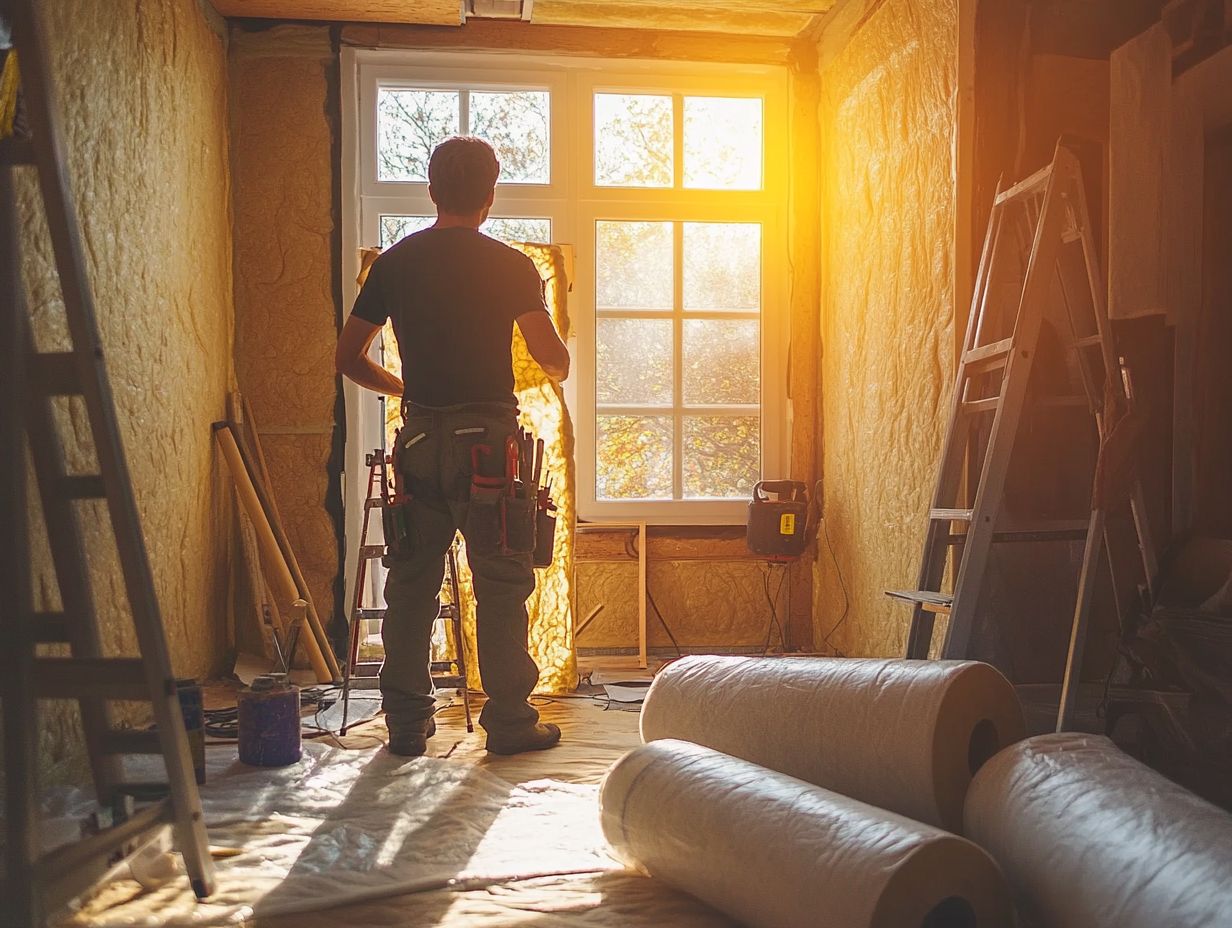
Deciding whether to hire a professional for your insulation project or tackle it yourself involves weighing various factors like expertise, cost, and project complexity.
Hiring professionals guarantees high-quality workmanship and compliance with safety standards. This can be elusive for a DIY novice. However, the upfront financial investment may feel daunting if you’re on a tight budget.
On the other hand, taking the DIY route can yield significant cost savings and a gratifying sense of accomplishment. Just remember, those savings might be reduced by potential missteps that require costly repairs or fail to achieve optimal energy efficiency, leading to higher utility bills down the road.
Frequently Asked Questions
What are some benefits of DIY insulation projects for homeowners?
Benefits of DIY insulation projects include cost savings, customization options, and a sense of accomplishment. Completing the project yourself saves money on labor and lets you choose the materials and methods that work best for your home. For optimal results, consider following the best insulation practices for homeowners. Finishing a DIY project gives you a sense of pride in improving your own space.
What are some common types of insulation used in DIY projects?
Common types of insulation used in DIY projects include fiberglass, cellulose, and spray foam. Fiberglass is popular due to its affordability and ease of installation. Cellulose is made from recycled materials and is environmentally friendly. For a comprehensive approach to insulation, consider following insulating your home: a step-by-step guide. Spray foam provides excellent insulation and can be used in hard-to-reach areas.
How do I determine what type of insulation to use for my DIY project?
The type of insulation you should use depends on factors such as budget, climate, and the areas of your home needing insulation. Research the different types of insulation and their benefits before making a decision.
What tools and materials will I need for a DIY insulation project?
The tools and materials required for a DIY insulation project vary based on the type of insulation chosen. Common items include a utility knife, staple gun, safety gear, and the insulation material itself. It s important to have all necessary tools and materials ready before starting the project.
Are there any safety precautions I should take when completing a DIY insulation project?
Yes, several safety precautions are essential when completing a DIY insulation project. Wear protective gear such as gloves, goggles, and a dust mask to avoid irritation from insulation materials. Additionally, work cautiously with tools and follow proper safety protocols to prevent accidents.
Do I need any special skills or knowledge to complete a DIY insulation project?
While previous experience in insulation installation can be helpful, special skills aren’t necessary for completing a DIY insulation project. With thorough research, proper tools, and attention to safety precautions, most homeowners can successfully complete a DIY insulation project, including learning how to upgrade your home’s insulation system.

